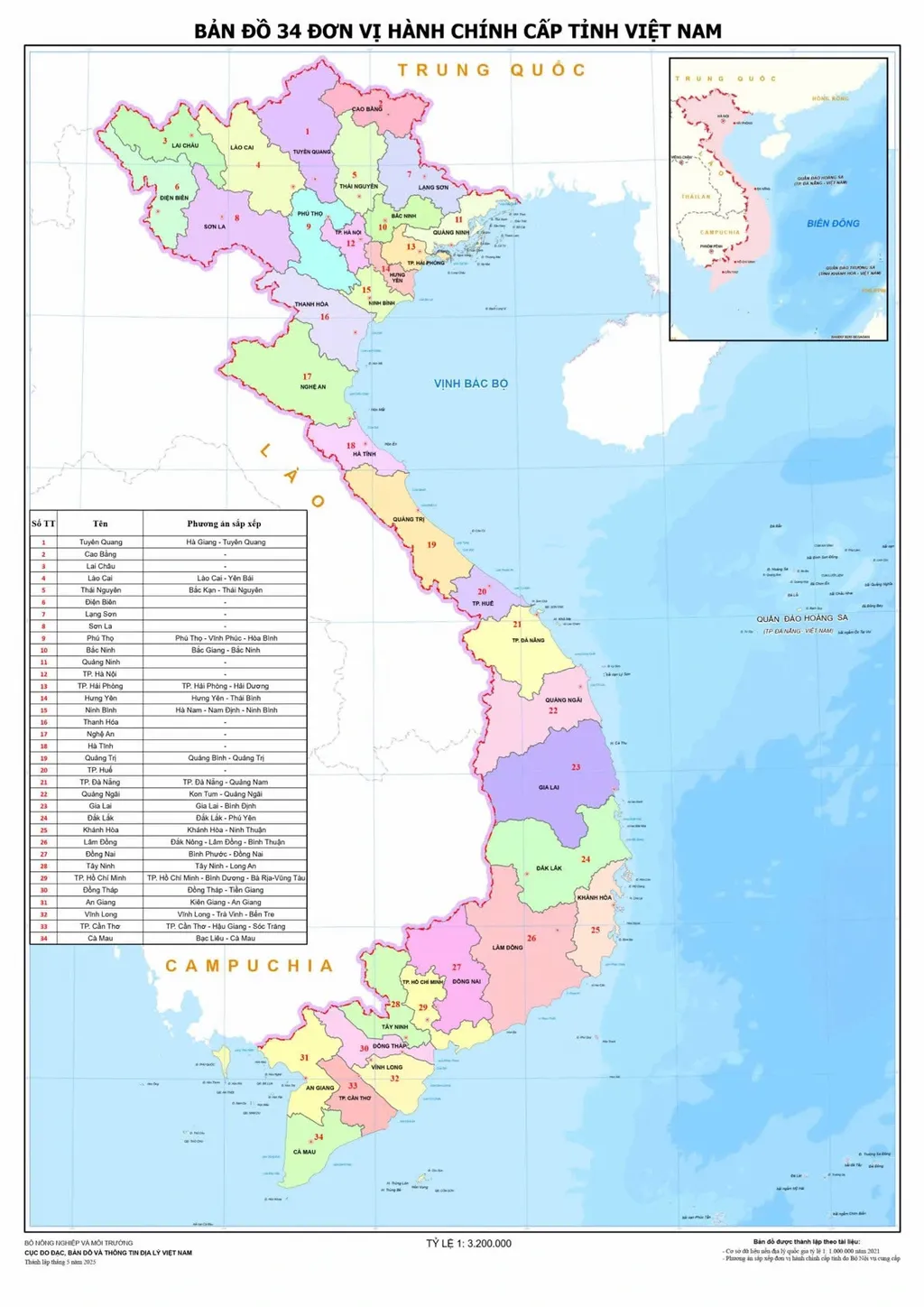 Politics & Law
Politics & Law

 |
| A view of Hà Nội. The city is among the 11 provinces and centrally-run cities that remain unchanged under the administrative reorganisation resolution. — VNA/VNS Photo |
HÀ NỘI — The National Assembly on Thursday passed a resolution to consolidate Việt Nam’s provincial-level administrative system, reducing the total number of provinces and centrally-run cities from 63 to 34.
The move, approved with overwhelming support — 461 out of 465 lawmakers voted in favour — marks the largest political reorganisation in the country since reunification.
Below is a detailed look at the newly restructured provinces and centrally-run cities:
1. Tuyên Quang Province (new)
Formed by merging Hà Giang and the former Tuyên Quang, the new province spans 13,795.5sq.km and has a population of 1,865,270.
It shares borders with Cao Bằng, Lào Cai, Phú Thọ, and Thái Nguyên, and the People’s Republic of China.
2. Lào Cai Province (new)
Created from Yên Bái and the former Lào Cai, the new province covers 13,256.9sq.km and has a population of 1,778,785.
It is bordered by Lai Châu, Phú Thọ, Sơn La, Tuyên Quang and China.
3. Thái Nguyên Province (new)
This newly formed province results from the merger of Bắc Kạn and the former Thái Nguyên, covering 8,375.2sq.km, with a population of 1,799,489.
Thái Nguyên shares borders with Bắc Ninh, Cao Bằng, Lạng Sơn, Phú Thọ, Tuyên Quang and Hà Nội.
4. Phú Thọ Province (new)
Combining Vĩnh Phúc, Hòa Bình and the former Phú Thọ, this new province spans 9,361.4sq.km and has a population of 4,022,638.
It borders Lào Cai, Ninh Bình, Sơn La, Thái Nguyên, Thanh Hóa, Tuyên Quang and Hà Nội.
5. Bắc Ninh Province (new)
Formed by uniting Bắc Giang and the former Bắc Ninh, this new province covers 4,718.6sq.km and has 3,619,433 people.
It borders Hưng Yên, Lạng Sơn, Quảng Ninh, Thái Nguyên, Hải Phòng and Hà Nội.
6. Hưng Yên Province (new)
The newly formed province arises from the merger of Thái Bình and the former Hưng Yên, covers 2,514.8sq.km and is home to 3,567,943 people.
It borders Bắc Ninh, Ninh Bình, Hà Nội, Hải Phòng, and the East Sea (internationally known as the South China Sea).
7. Hải Phòng City (new)
The expanded city comprises Hải Dương and the former Hải Phòng, encompassing 3,194.7sq.km and a population of 4,664,124.
Hải Phòng shares boundaries with Bắc Ninh, Hưng Yên, and Quảng Ninh and is bordered on the east by the East Sea.
8. Ninh Bình Province (new)
Formed by combining Hà Nam, Nam Định and the former Ninh Bình, this new province spans 3,942.6sq.km and has 4,412,264 people.
Ninh Bình is bordered by Hưng Yên, Phú Thọ, Thanh Hóa, Hà Nội, and the East Sea.
9. Quảng Trị Province (new)
This province is the result of merging Quảng Bình and the former Quảng Trị. It has an area of 12,700sq.km and a population of 1,870,845.
Quảng Trị shares borders with Hà Tĩnh, Huế City, Laos and the East Sea.
10. Đà Nẵng City (new)
The expanded city consists of Quảng Nam and the former Đà Nẵng, spanning 11,859.6sq.km and housing 3,065,628 people.
It borders Quảng Ngãi, Huế City, Laos and the East Sea.
11. Quảng Ngãi Province (new)
This newly established province is a merger of Kon Tum and the former Quảng Ngãi, covering 14,832.6sq.km and a population of 2,161,755.
Quảng Ngãi borders Gia Lai, Đà Nẵng City, the East Sea, and also shares international frontiers with Laos and Cambodia.
12. Gia Lai Province (new)
This province arises from the merger of Bình Định and the former Gia Lai, spanning 21,576.5sq.km with a population of 3,583,693.
Gia Lai borders Đắk Lắk, Quảng Ngãi, the East Sea and Cambodia.
13. Khánh Hòa Province (new)
A new coastal province combining Ninh Thuận and the former Khánh Hòa. It covers 8,555.9sq.km, with a population of 2,243,554.
Khánh Hòa shares borders with Đắk Lắk, Lâm Đồng and the East Sea.
14. Lâm Đồng Province (new)
Formed from Đắk Nông, Bình Thuận and the former Lâm Đồng, this new province has an area of 24,233.1sq.km and a population of 3,872,999.
Lâm Đồng borders Đắk Lắk, Đồng Nai, Khánh Hòa, HCM City, Cambodia and the East Sea.
15. Đắk Lắk Province (new)
This province is the result of a merger between Phú Yên and the former Đắk Lắk, spanning 18,096.4sq.km with 3,346,853 people.
Đắk Lắk shares borders with Gia Lai, Khánh Hòa, Lâm Đồng, Cambodia and the East Sea.
16. Hồ Chí Minh City (new)
Now expanded to comprise Bà Rịa–Vũng Tàu, Bình Dương and the former HCM City, the new city spans 6,772.6sq.km with a population of 14,002,598.
HCM City borders Đồng Nai, Đồng Tháp, Lâm Đồng, Tây Ninh and the East Sea.
17. Đồng Nai Province (new)
This new province combines Bình Phước and the former Đồng Nai, covering 12,737.2sq.km with 4,491,408 people.
Đồng Nai is bordered by Lâm Đồng, Tây Ninh, HCM City and Cambodia.
18. Tây Ninh Province (new)
Created from the merger of Long An and the former Tây Ninh, this new province stretches 8,536.4sq.km with 3,254,170 people.
Tây Ninh borders Đồng Nai, Đồng Tháp, HCM City and Cambodia.
19. Cần Thơ City (new)
A strategic combination of Sóc Trăng, Hậu Giang and the former Cần Thơ, the new city spans 6,360.8sq.km and has a population of 4,199,824.
Cần Thơ borders An Giang, Đồng Tháp, Cà Mau, Vĩnh Long and the East Sea.
20. Vĩnh Long Province (new)
This province emerges from the merger of Bến Tre, Trà Vinh and the former Vĩnh Long. Its area is 6,296.2sq.km, and its population stands at 4,257,581.
Vĩnh Long borders Đồng Tháp, Cần Thơ City and the East Sea.
21. Đồng Tháp Province (new)
Formed by merging Tiền Giang and the former Đồng Tháp, this new province spans 5,938.6sq.km and has a population of 4,370,046.
Đồng Tháp borders An Giang, Tây Ninh, Vĩnh Long, Cần Thơ, HCM City, Cambodia and the East Sea.
22. Cà Mau Province (new)
Created by merging Bạc Liêu and the former Cà Mau, this new province has an area of 7,942.4sq.km and a population of 2,606,672.
Cà Mau borders An Giang, Cần Thơ and the East Sea.
23. An Giang Province (new)
This expansive province covers Kiên Giang and the former An Giang, spanning 9,888.9sq.km with 4,952,238 people.
An Giang shares borders with Cà Mau, Đồng Tháp, Cần Thơ, Cambodia and the East Sea.
Only 11 localities remain unchanged under the administrative overhaul. These are Cao Bằng, Điện Biên, Lai Châu, Lạng Sơn, Nghệ An, Hà Tĩnh, Quảng Ninh, Thanh Hóa, Sơn La, and the cities of Hà Nội and Huế.
While the newly merged units are now legally in effect, existing local governments will continue to operate until new provincial and municipal administrations are officially established.
The Government is tasked with finalising boundaries, updating administrative maps and managing the transition of public officials. — VNS
 |
| Map of the 34 localities. — Photo from the Ministry of Agriculture and Environment |




